NIKKOR - The Thousand and One Nights No.79

A standard lens for landscape photography that produced many masterpieces
W-Nikkor·C 2.8cm f/3.5
Tale 79 continues the story of NIKKOR lenses for rangefinder camera following Tale 77. The 74° angle of view of 28-mm lenses is, and always has been, very convenient for landscapes and snapshots. In this tale, we'll uncover the secrets of a lens that produced many masterpieces and was a favorite of many photographers. What sort of lens was the W-Nikkor·C 2.8cm f/3.5? What secrets were hidden behind its development, and who designed it? Let's look at these details.
by Haruo Sato
I. The history of wider angles
It is no exaggeration to say that modern photographic lenses evolved from the invention of the triplet. The most noteworthy feature of the triplet is, for better or for worse, the high-power concave middle lens element. This concave lens corrects a large amount of aberration, and contributes greatly to designers' ability to achieve faster (brighter) apertures. However, the major drawback of this structure is that the existence of this biconcave element prevents larger angles of view. Therefore, improvements to the structure have resulted in many different types of triplet. The Topogon is one of these that is the result of the switch from the convex-concave-convex (positive-negative-positive) structure to a convex-concave-(aperture)-concave-convex structure. A different approach was taken to achieve the Clark structure, which ultimately led to the invention of the Gauss structure. With both the Gauss and Topogon structures, we can regard the two concave elements on either side of the aperture as a single element and, therefore, the same power arrangement and structure as the original convex-concave-convex triplet can be achieved. Actually, this way of thinking originated in Japan. It was thought that the power arrangement of all symmetric objectives can somehow be explained by the triplet. For example, even the concave-convex-concave (concave-convex-convex-concave) Biogon structure is considered another type of triplet. It is not too much to say that the key to success in the battle for wider angles lay in how the concave element in the middle of the triplet was modified. In my youth, I was extremely sympathetic to this way of thinking, and I began to think of everything based on the triplet structure. You could definitely say I was a true believer. That is, until I met a certain lens structure.
II. The mysterious Orthometar
I did come across a rather mysterious lens structure. It was the Orthometar structure. I initially assumed that this structure was also a concave-convex-convex-concave (negative-positive-positive-negative) structure, but after studying various lenses made with this structure, I realized that the large doublets in front and rear of the 6-element, 4-group structure may work either as concave or, as is equally possible, as convex. Further, they could also be neutralized, or have almost no power. That meant that even a convex-convex-convex-convex structure would work. "But that's not a triplet structure. How is this possible?" I wondered. I struggled with this because we had a lot of products made using the Orthometar structure, including large-format, Apo-, and EL-Nikkor lenses. Indeed, my predecessors were all familiar with the Orthometar structure. I began looking into the matter from every angle. I found that the elements on either side of the aperture that I thought were convex could actually be a doublet with negative power. I didn't know what to think of this. Unable to come up with an answer myself, I finally consulted with an expert in optics. He told me that there is a problem with thinking of everything as a triplet structure. There is always a concave element in a convex compound. If you think that aberrations are corrected in order, then you can correct aberrations even with a convex-convex structure. My eyes were opened! Certainly, three or four elements were joined, as with the double-Anastigmat, to create lens blocks that corrected aberrations before the triplet was invented. If you think of the Orthometar structure as an extension of this, the means used to correct aberrations is clear. I thanked him and went home with new understanding and feeling much better.
III. Development history and the designer
Now let's take a look at W-Nikkor·C 2.8cm f/3.5 development history. The best Japanese designers don't like to stand out and their names are not commonly known, but they have left their mark on numerous reports and patents. Submission of the optical design report for this lens was recorded in January of 1952. It is unknown, however, when work on the design actually began. The mass-production drawing was also issued in January of 1952, meaning that mass production began sometime in 1952. I have heard that it was common at the time to submit the report at the same time as the drawings, after things had calmed down, rather than immediately after the design was completed. In addition, mass-production drawings were handled a little differently then than they are now. Mass-production orders were issued once designs were completed, and prototypes were made as part of these orders to verify mass-production compatibility/feasibility and performance. Only those with which excellent results were achieved would be mass produced and released. Therefore, some lenses were discontinued prior to actual mass production and not released, even if the mass-production order had been issued. This method was also adopted for the W-Nikkor·C 2.8cm f/3.5. Optics were changed after trial production as the final design for mass production. It was originally an f/4 lens but was changed to an f/3.5 lens in March of 1952. It is likely that a small number of 2.8cm f/4 lenses were produced in accordance with the mass-production order, but the lens was finally released as the 2.8cm f/3.5. I believe that all f/4 lenses were scrapped. Just why was the aperture increased to f/3.5? What means was used to increase the aperture to f/3.5? Let's think about that.
The W-Nikkor·C 2.8cm f/3.5 was released in September of 1952. Exactly one year before that, other company had released its Serenar 28mm f/3.5. Possibly, Nikon had originally planned on a maximum aperture of f/4, but quickly revised its design to f/3.5 with the introduction of the Serenar 28mm f/3.5. But, is it possible to achieve a faster (brighter) aperture so easily? I compared design data for the f/4 and f/3.5 versions of the lens. I found that the design was very simple and straightforward in terms of not only near the optical axis, but in the region of third-order aberrations. It can be said that design values had good margins. Traditionally, Nikon designed lenses first for optimal paraxial optical properties, then address third-order aberrations, and so on. As a result, spherical aberration and coma did not increase significantly even with the increase in aperture size from f/4 to f/3.5. That is why it was relatively easy to increase the aperture to f/3.5. There was, however, one aspect to which they turned a blind eye. That was the volume of peripheral light. This lens exhibited a little less peripheral light than do other wide-angle lenses in the same class. That was this lens' only fault.
Now let's take a look at the designer. Masaki Isshiki, who worked in Nikon's research department at the time, designed the optics. He also did amazing work designing fisheye lenses. In fact, Isshiki designed the SAP Fisheye-Nikkor 6.2mm f/5.6, a fisheye lens with a solid-angle projection system that covered 230°, manufactured in 1969 (see NIKKOR - The Thousand and One Nights, Tale 53). While mastering optical design, Isshiki also took the lead in introducing computers and software development at Nikon. He was always trying new things, and his efforts always paid off. That is just how he lived. In 1988 he replaced my mentor, Mr. Shiomi, as a professor in the Faculty of Engineering at Tokyo Polytechnic University, devoting his later years to training optical engineers. Sadly, he passed away in 2019 at the age of 92, while still an optical engineer. He traveled the world over for academic conferences and study sessions until just before he passed. Isshiki contributed greatly to the Japan Society of Applied Physics, and students today are actively making use of the teachings of Professor Isshiki in a variety of fields.
IV. Lens construction and characteristics

Now let's take a look at a cross-section of the W-Nikkor·C 2.8cm f/3.5 (Figure 1). Please forgive me if the following is quite technical. This lens is constructed with a typical six-element Orthometar structure.
Let's consider the order in which light rays pass through the lens from the left. First they pass through a concave doublet made up of a high-power convex element and a high-power concave element. They then pass through a meniscus-shaped convex element, the aperture, a meniscus-shaped convex element with the protruding side facing the imaging surface, and finally a convex doublet comprised of a high-power concave element and a high-power convex element. Therefore, this lens has a concave-convex-convex-convex (negative-positive-positive-positive) structure, that is not a triplet. However, if the individual elements making up the doublets are separated, the structure becomes a convex-concave-convex convex-concave-convex structure for good aberration compensation capabilities. There are also high-power concave air lenses (with a convex shape) between the doublet and meniscus element on either side of the aperture. These air lenses provide good compensation for spherical aberration. With the exception of joint surfaces, the lens structure is quite concentric around the aperture. This means that off-axis light rays can be let in straight making it a structure clearly suited to wide-angle lenses. This sort of structure is unable to correct spherical aberration. That is why it utilizes the air lenses mentioned previously. Therefore, this structure is not suitable for faster (brighter) apertures. That is why there are no bright (fast) f/2 or f/1.4 Orthometar lenses. Moreover, the front and rear doublets used by the W-Nikkor·C 2.8cm f/3.5 are new achromatic elements that correct chromatic aberration and improve the Petzval sum. While this is another advantage for correcting curvature-of-field and astigmatism, it also makes it difficult to achieve faster (brighter) apertures.
V. Design performance and evaluation
First let's look at design data. As I have always stated, evaluations are both subjective and relative. Please use my own evaluations merely as reference when viewing sample images.
As I mentioned above, this lens is quite symmetrical. It is a well-known fact that this type of structure exhibits very little distortion, and extremely little lateral chromatic aberration. But what about other aberrations? Let's consider spherical aberration first. There is slight under correction of spherical aberration. This is a technique intentionally adopted to match the best point (peripheral focal plane) that is displaced in the negative direction at image edges due to relatively large curvature-of-field. This lens has a slightly larger Petzval sum (approx. 0.009) than do common Orthometar structures. Conventionally, a larger Petzval sum means the curvature-of-field value is large in the negative direction. Therefore, the sagittal plane is still influenced by the relatively large Petzval sum with this lens, and to match the best point, spherical aberration must remain under-corrected. The meridional plane is corrected to quite a flat surface. It forms an S-shaped curve with the intersection point (origin) at an image height of 10-15 mm. Considering the effects of astigmatism, the meridional plane should be positioned more negatively and aligned with the sagittal plane. However, due to the large Petzval sum, it was probably determined that that design method was not advisable. We'll check the effects achieved with this design later with a spot diagram and MTF charts. What about meridional coma? There is very little near the paraxial pupil ray, and a large amount of flare suddenly appears near the pupil at every image height. This indicates aberration compensation that improves background blur. The three-dimensional rendering characteristics of this lens are pleasing despite the fact that it is a medium-speed wide-angle lens. Also noteworthy is the very small amount of sagittal coma. This is a very advantageous characteristic for a wide-angle lens. A maximum aperture of f/3.5 is not especially fast, but this lens can be reliably used for night landscapes all the way from that maximum aperture. How about variations in aberrations at short distances? Conventionally, symmetric objective lenses were characterized by little variations in aberration due to changes in magnification. As one would expect, such variation in aberration is not a concern with this lens, even with shooting at the minimum focus distance. However, it does have a minimum focus distance of approximately one meter, or a reproduction ratio of around 1/30, so there really should be no significant variation in aberration.
Next, let's look at point-image intensity distribution and spot diagrams. Reproduction is extremely good at the center of the frame, due in part to the f/3.5 maximum aperture. In addition, with little sagittal coma throughout the entire off-axis region, point images are well formed. At intermediate angles of view, points are a little more elongated in the vertical direction due to meridional coma. However, performance is not as affected by astigmatism as one would expect. Point images have a core surrounded by flare at every image height. These cores are unidentifiable at the extreme edges of the frame, but good resolution can be expected from the center of the frame, through the mid ranges, to frame peripheries. With little lateral chromatic aberration, the energy concentration of each color is high, and conditions favorable to good resolution are achieved.
Now let's look at the MTF charts. Let's check contrast reproduction at 10 lines/mm and 30 lines/mm. Contrast at the center of the frame is extremely high (80% or more) at 30 lines/mm. The lines tend to fall gradually as the distance from the center increases, and contrast decreases. When this happens, reducing contrast just a little at the center of the frame by focusing on something slightly in front of the intended focal point will raise the lines at the peripheries. This improves the average image quality throughout the frame, and can increase peripheral contrast at 30 lines/mm to 20-40%. At 10 lines/mm, contrast is roughly 60-70% all the way to the extreme edges of the frame. The same is generally true with shooting at short distances. The average image quality achieved with this lens could probably be improved throughout the frame by focusing on something just slightly in front of the intended subject, or on an object slightly above, below, or to the side of the center of the frame. In any case, the level of performance achieved by this lens is sufficient to support use with modern photo systems.
VI. Actual performance
Next let's look at results achieved with some actual images of distant scenes. I used the Nikon Z 7 with a third-party mount adapter this time as well. My lens is equipped with a Leica L mount. The lens I used for this Tale was entrusted to me by my teacher, Kiyoshi Hayashi, as a memento. I once refused it because accepting it seemed rather morbid and I want him to live an even longer life. However, after I heard that he wanted me to make the lens the topic of a NIKKOR The Thousand and One Nights tale, I accepted the lens and determined to treasure it. I was also deeply moved when I learned that that particular lens was the work of a young Isshiki. Naturally, I was eager to try it out.
Now I will explain performance at each aperture setting in detail. Evaluations are subjective, and based on individual preferences. Please keep in mind that my opinions on sample images and evaluations are for reference purposes only.
f/3.5 maximum aperture
The entire frame seems to be enveloped in a pleasing flare that is like a thin veil. However, resolution is generally good, and particularly high at frame center and mid ranges. Inner coma flare gradually increases closer to the edges of the frame. The effects of chromatic aberration are small. There is no color bleed for an overall good impression. The amount of light in frame peripheries is relatively small, and drops off sharply. Rendering characteristics are indicative of those common to wide-angle lenses of that time.
f/4
Stopping down the aperture just one stop reduces flare at the center of the frame and in mid ranges. Contrast increases. Image quality at the center of the frame, especially contrast, increases. The amount of light that reaches frame peripheries is increased significantly.
f/5.6
Flare is nearly eliminated everywhere except the extreme edges of the frame. Overall sharpness increases. Resolution remains high, and stopping down the aperture increases contrast and image clarity.
f/8
Contrast increases even further. Image quality is excellent despite some flare remaining at the extreme edges. This is the aperture setting with which high image quality is achieved throughout the entire frame that I recommend for everyday use.
f/11
Consistently good image quality is maintained throughout the frame. While image quality increases at f/5.6, f/8, and f/11, aperture settings of f/8 to f/11 are recommended to achieve the depth of field suited to landscapes.
f/16 to f/22
Flare at the extreme edges of the frame disappears, and while there is more consistency throughout the frame, resolution is clearly reduced. This is likely the result of diffraction.
f/8 to f/11 are likely best for landscapes. f/3.5 to f/4 are good for making the most of the wide angle with snapshots.
VII. Sample images
Now let's confirm these rendering characteristics with some sample photos.
Portrait and other Picture Controls that apply less sharpening are generally used for sample images captured for use in NIKKOR The Thousand and One Nights tales in order to best judge the characteristics of the lens. However, as many of the samples I've captured for this tale are landscapes, I chose to use Auto Picture Control with some of them. Further, no special compensation including sharpening was applied to enhance image sharpness. I concentrated on capturing the sorts of landscape snapshots I assume general users of this lens would capture.

Nikon Z 7 with L-Z third-party adapter and W-Nikkor·C 2.8cm f/3.5
Aperture: f/3.5 (maximum aperture)
Shutter speed: 1/640 s
Exposure compensation: -1/3 EV
Sensitivity: ISO 100
Image quality: RAW
White balance: Auto
D-Lighting: Auto
Picture Control: Auto
Date of capture: July 2020
Sample 1 was shot at f/3.5 (maximum aperture), with focus set almost at infinity. The image is a little soft, but the normal print area exhibits sufficient sharpness. The peripheral illumination falloff isn't a major problem with this composition. There is also no clear drop in sharpness in the intermediate and peripheral portions of the frame.

Nikon Z 7 with L-Z third-party adapter and W-Nikkor·C 2.8cm f/3.5
Aperture: f/3.5 (maximum aperture)
Shutter speed: 1/4000 s
Sensitivity: ISO 100
Image quality: RAW
White balance: Auto
D-Lighting: Auto
Picture Control: Auto
Date of capture: July 2020
Sample 2 was also shot at f/3.5 (maximum aperture), with focus set almost at infinity. The image is still a little soft, but the normal print area exhibits sufficient sharpness. The peripheral illumination falloff isn't a major problem with this composition. There is also no clear drop in sharpness in the intermediate and peripheral portions of the frame. You can see that the image exhibits extremely good resolution even when it is enlarged for viewing at 100%. Details such as the individual light bulbs, spectator seating, and the engravings in the wall are sharp and clear.

Nikon Z 7 with L-Z third-party adapter and W-Nikkor·C 2.8cm f/3.5
Aperture: f/3.5 (maximum aperture)
Shutter speed: 1/3200 s
Exposure compensation: -1/3 EV
Sensitivity: ISO 100
Image quality: RAW
White balance: Direct sunlight
D-Lighting: Auto
Picture Control: Auto
Date of capture: July 2020
Sample 3 was also shot at f/3.5 (maximum aperture). Focus was set to infinity for this image. Image quality is good with sufficient sharpness and detail, as well as a pleasing degree of contrast. I framed the image so that the majority of it was sky to show the amount of peripheral illumination falloff. Clearly, the fact that there is a significant amount of shading in the extreme corners cannot be denied.
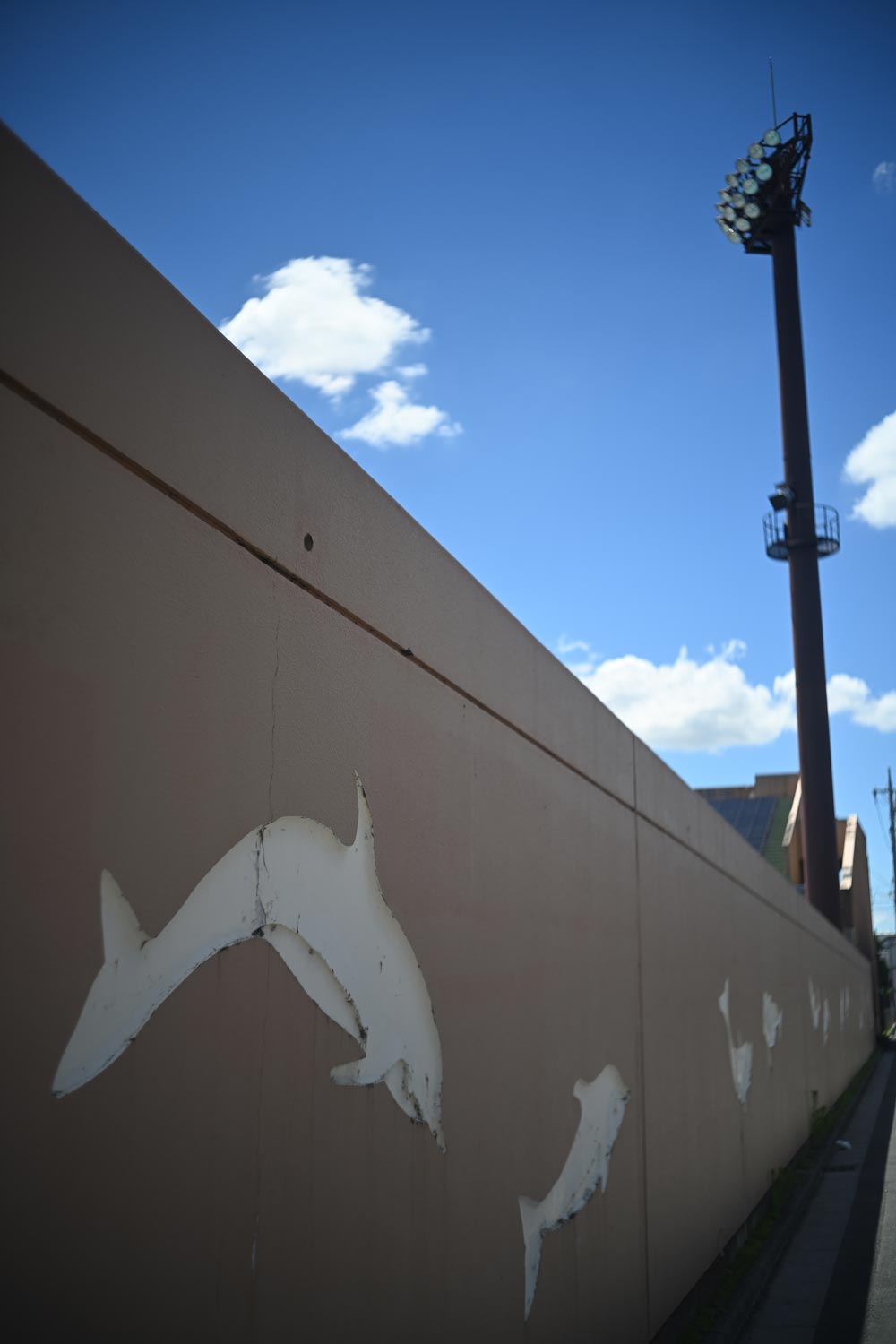
Nikon Z 7 with L-Z third-party adapter and W-Nikkor·C 2.8cm f/3.5
Aperture: f/3.5 (maximum aperture)
Shutter speed: 1/2000 s
Sensitivity: ISO 100
Image quality: RAW
White balance: Auto
D-Lighting: Auto
Picture Control: Auto
Date of capture: July 2020
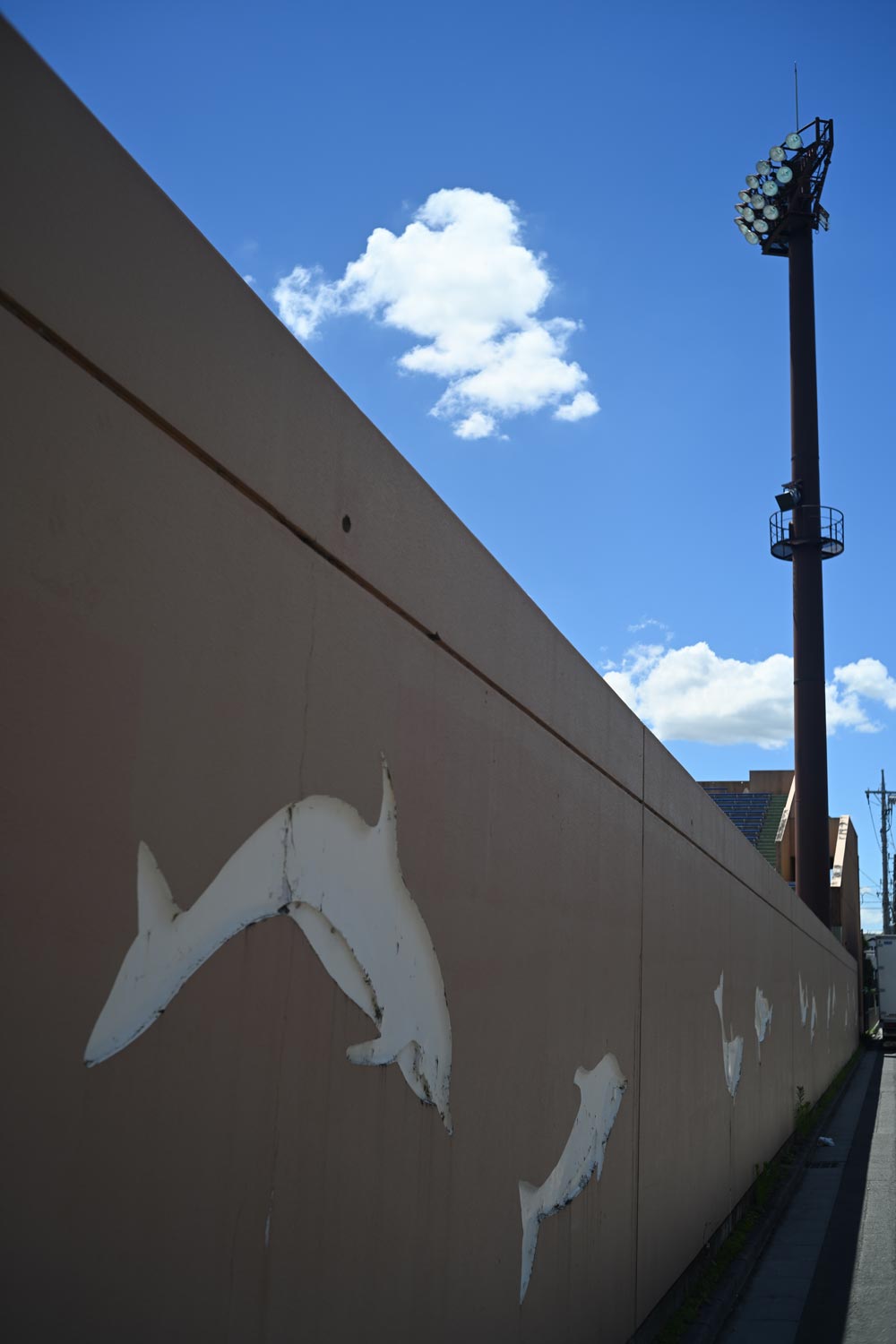
Nikon Z 7 with L-Z third-party adapter and W-Nikkor·C 2.8cm f/3.5
Aperture: f/8
Shutter speed: 1/640 s
Sensitivity: ISO 100
Image quality: RAW
White balance: Auto
D-Lighting: Auto
Picture Control: Auto
Date of capture: July 2020
Let's compare samples 4 and 5. Sample 4 was shot at f/3.5 (maximum aperture), and sample 5 at f/8. The reproduction ratio is approximately 1/30x, and the minimum focus distance is 1 m. Focus was acquired on the dolphin engraving nearest the camera, so the light pole in the background is out of focus. Looking at sample 5, you can see that focus is quite deep at an aperture setting of f/8. Unfortunately, the effective depth of field does not cover infinity. This comparison also shows the difference in the amount of peripheral illumination between the two aperture settings. If the intent is to achieve a wide-angle feel with a sharp drop in the amount of light at frame peripheries, I recommend using near maximum apertures. If the intent is a more detailed landscape, I recommend stopping down the aperture to f/8 to f/11.
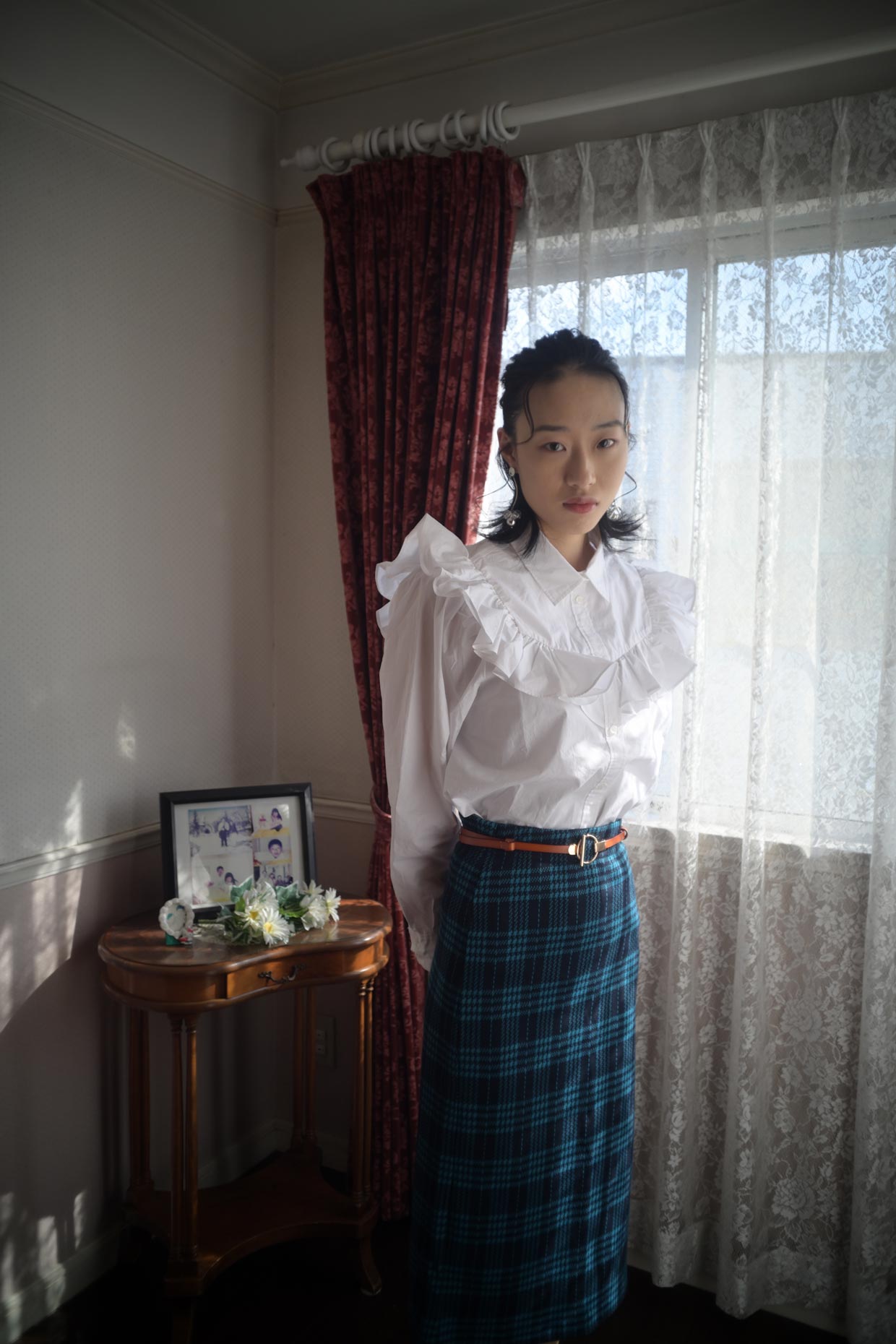
Nikon Z 7 with L-Z third-party adapter and W-Nikkor·C 2.8cm f/3.5
Aperture: f/3.5 (maximum aperture)
Shutter speed: 1/800 s
Sensitivity: ISO 400
Image quality: RAW
White balance: Auto
D-Lighting: Auto
Picture Control: Portrait
Date of capture: September 2020
I tried a half-backlit portrait for sample 6. This portrait was shot at f/3.5 (maximum aperture). There is a little flare, but focus is sharp and clear. Anyone can see that this lens can be used without concern from maximum aperture.
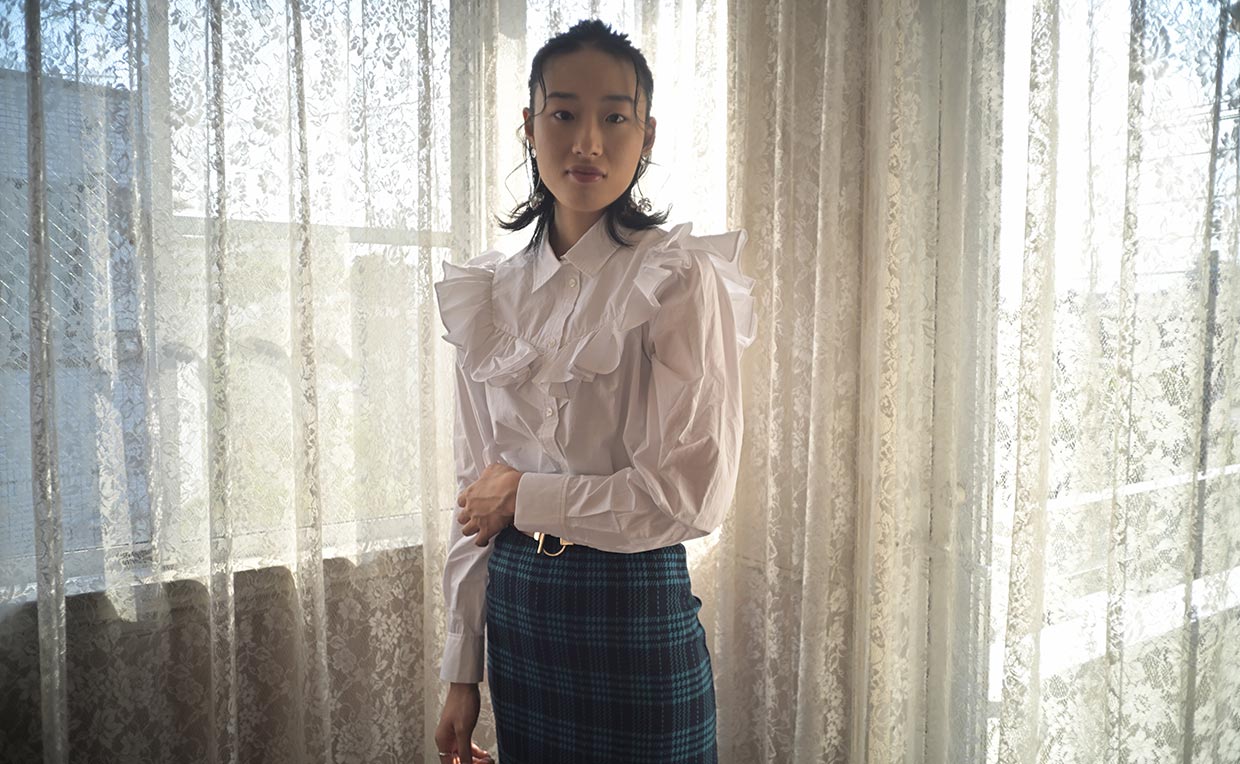
Nikon Z 7 with L-Z third-party adapter and W-Nikkor·C 2.8cm f/3.5
Aperture: f/3.5 (maximum aperture)
Shutter speed: 1/800 s
Exposure compensation: +1.0 EV
Sensitivity: ISO 400
Image quality: RAW
White balance: Auto
D-Lighting: High
Picture Control: Standard
Date of capture: September 2020
Just as with sample 6, I tried another portrait for sample 7. This image is entirely backlit, and was shot at f/3.5 (maximum aperture). In addition to the flare caused by the optics, flare due to non-optical factors including the lens barrel and mount adapter is conspicuous. Resolution is sufficient for this type of scene, but please note that I did increase contrast slightly to compensate for flare caused by non-optical factors.
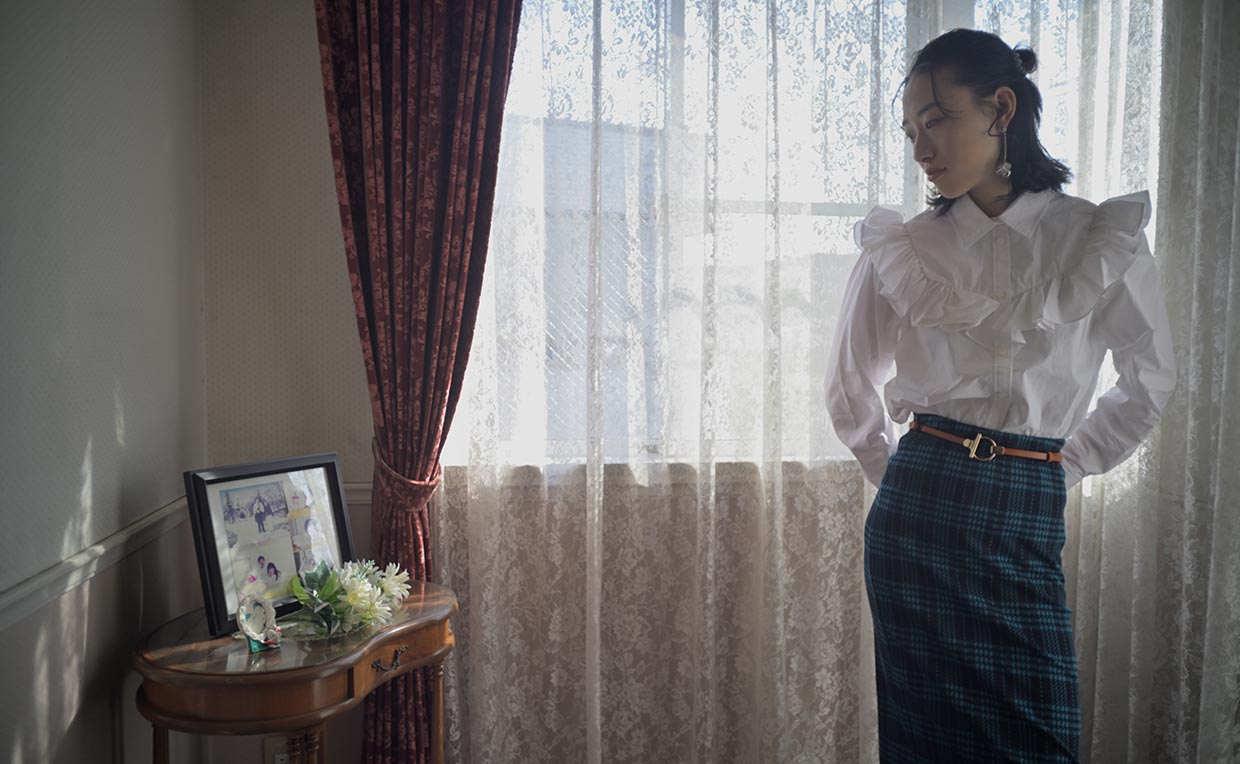
Nikon Z 7 with L-Z third-party adapter and W-Nikkor·C 2.8cm f/3.5
Aperture: f/3.5 (maximum aperture)
Shutter speed: 1/500 s
Exposure compensation: +1.0 EV
Sensitivity: ISO 400
Image quality: RAW
White balance: Auto
D-Lighting: High
Picture Control: Portrait
Date of capture: September 2020
Sample 8 is another portrait test. This image represents the worst possible backlighting conditions. It was shot at f/3.5 (maximum aperture). Again, flare is a little conspicuous due to non-optical factors including the mount adapter. Resolution is sufficient for this type of scene, but please note that I did increase contrast slightly to compensate for that flare.
When shooting these samples, I used all aperture settings, but for the most part, included only those captured at maximum aperture here. This lens performed well in terms of image quality at aperture settings of f/8 to f/11 that are often used for capturing landscapes. Clearly, it is a wide-angle lens good for almost any scene or subject. I think the characteristics of the Orthometar structure, especially the relative lack of chromatic aberration, have contributed to this. Isshiki succeeded in designing a truly wonderful lens.
VIII. Who was Masaki Isshiki?
To me, Isshiki was the embodiment of a university professor. I didn't have the chance to learn from him while I was a student, but many of those who came after me did. At first glance, Professor Isshiki appeared quiet, sophisticated, and mild mannered. In fact, he was very energetic. His passion for optics was more intense than that of his young students, and until his later years, he traveled around the world to attend academic conferences. For the past few years, after the age of 90, he was accompanied by a young researcher. Even with a schedule that would exhaust that young attendant, his youthful outlook and ready smile made it seem easy. Isshiki designed many lenses, but the one for which is most remembered was of course the SAP Fisheye-Nikkor 6.2mm f/5.6. With that lens, he achieved the ground-breaking invention that is the solid-angle projection system that exceeded the 180° angle of view with coverage for an incredible 230° angle of view in the 1960s. What is incredible is that rays exceeding 180° were accurately calculated using ray tracing calculation of those days. When developing calculating software for a computer, an angle of view that exceeds 180° means that light drops off from the image side. That must have been most annoying. There were only a few design examples in the world. That is the time and technical environment in which the solid-angle projection system and SAP Fisheye-Nikkor 6.2mm f/5.6 were achieved. This level of achievement is the equivalent of a Guinness world record. This lens with its 230° angle of view was the world's first, and the only photographic lens to have such a large angle of view at that time. I'm sure Isshiki would have developed the software needed to design this lens himself as there was no software capable of doing so. I think Isshiki acquired his abilities as a software developer through his own research. The optical design software we use today has been further improved and refined based on the initial work of Isshiki and others. Masaki Isshiki passed away in 2019 at the age of 92. Isshiki remained energetic and active on the front lines of the optics world until the very end. His students will forever carry his many achievements into the future.

NIKKOR - The Thousand and One Nights
The history of Nikon cameras is also that of NIKKOR lenses. This serial story features fascinating tales of lens design and manufacture.

